ABSTRACT
Sericulture is a Vietnamese traditional job and is also a source of livelihood for many farmers. This is why it is important to do research work on Vietnamese sericulture value chain in order to come up with solutions for development in the future. The research methods include approaching value chain; and approaching with participatory, secondary and primary information collection methods. The research has shown that Lam Dong province fits the criteria and requirements of mulberry growing area, cocoons yield, silk yield and silk, thread export turnover accounting for 77% to 99% of the whole country. There are three main types of silkworms that are being used by farmers, in which the bivoltine white cocoon silkworm has higher silk yield and quality, so it occupies for 100% of silkworm farming households in the Northern Mountainous region (MNPB) and the Central Highlands and 40% of households in Red River Delta. The value chain diagram shows that there are many actors participating in the chain such as silkworm eggs suppliers, sericulture households, cocoons collectors and silk weavers. Analyzing the characteristics of the actors within the value chain shows that silkworm egg source depends mainly on China (imported 95%); The link among actors is still loose; Production techniques and technology are still outdated in the Red River Delta and the Northern Mountainous region. Sericulture households have low income per working day, so they cannot attract the participation of young workers. From the existing difficulties, solutions have been proposed including creating linkages between production and consumption and transfer of technology; building a Vietnamese silk brand, promoting and introducing products associated with tourism; diversifying designs and products to supply the domestic market.
Keywords: value chain, sericulture, Vietnam
INTRODUCTION
Sericulture is a traditional job of Vietnam with characteristics of a combination of cultivation, animal husbandry, processing technology and art. Despite the fierce competition of many types of synthetic silk produced in large volumes at a low cost, it still cannot replace the position of traditional silk because of its unique characteristics such as continuous length, softness and its being environmentally friendly. Sericulture is still a source of livelihood for many farmers across the country. In recent times, along with the increase in consumer demand for high-quality silk products from major markets around the world such as Japan, India, Italy, France, etc. it has promoted the development of Vietnamese sericulture. The total export value has reached US$60 million making Vietnam belong to the group of 5 largest silk producing countries in the world (www.inserco.org, accessed October 22, 2020). However, due to the limitations of farmers, especially the small mulberry growing area, the Vietnamese sericulture is having a strategic shift from the traditional region of Red River Delta to mountainous regions such as Lam Dong in the South and Yen Bai in the North, etc. (Report - Vietnam Sericulture Research Centre). It is important to study the Vietnamese sericulture value chain in order to assess the current operational status, thereby identifying difficulties and obstacles and proposing solutions to develop the Vietnamese sericulture value chain in the near future.
METHODS
Methods: using the approaching value chain and participatory methods to fully assess the organization, participation and role of actors in the agriculture value chain.
Information collecting methods:
- Collecting secondary information: Statistical data, research reports, summary reports, programs, projects, documents and policies related to the consumption status of Vietnamese sericulture products in the domestic and international markets.
- Collecting primary information:
- Survey location: Based on statistics data, in recent years, there has been a significant change in mulberry growing area in ecoregions. The Central Highlands and Northern Mountainous region expanded the production scale, whereas the provinces of the Red River Delta (RRD) and the North Central region had a sharp decrease in the area of mulberry cultivation. These are four regions selected for the research to point out the causes leading to changes in sericulture. In each region, the research selects representative provinces with many households and groups of actors participating in the value chain for investigation. The representative provinces include Yen Bai, Lao Cai (Northern Mountainous region); Ha Nam, Nam Dinh and Thai Binh (Red River Delta); Thanh Hoa (North Central region); Lam Dong (Central Highlands region).
- Primary information is collected through interviews and discussions with groups of actors involved in the Vietnamese sericulture value chain such as producers, collectors, purchasing agencies, processing enterprises, exporter, wholesalers and retailers. In addition, the research team also interviews the representatives State local management agencies including Agriculture and Rural Development Department in some provinces and districts, People's Committees of some communes of representative provinces. Using a semi-structured questionnaire that was built according to different groups of actors.

Collecting and processing information methods: The collected information is classified and sorted according to different criteria. The surveyed data is organized and processed on the computer using Microsoft Excel (Table 1).
RESULTS AND DISCUSSIONS
Overview of Vietnam sericulture production
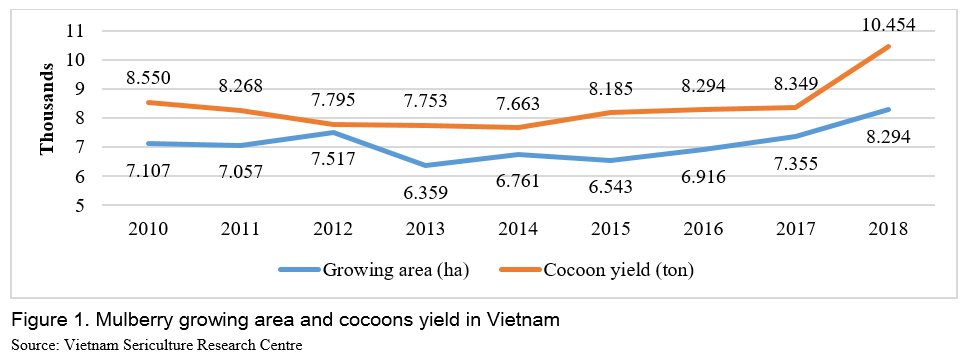
From 2010 to 2014, mulberry growing area and cocoons yield decreased. The growing area reduced from 8,550 ha (2010) to 7,663 ha (2014), the cocoons yield decreased from 7,107 tons (2010) to 6,543 tons (2015). Between 2016 and 2018, the mulberry growing area and cocoons yield increased, reaching 10,454 ha and 8,294 tons respectively. One of the main reasons for this change is the increase of cocoons price. In 2017, the highest cocoons selling price reached US$7.4/kg and was 1.5 times higher than in the previous period (Figure 1).
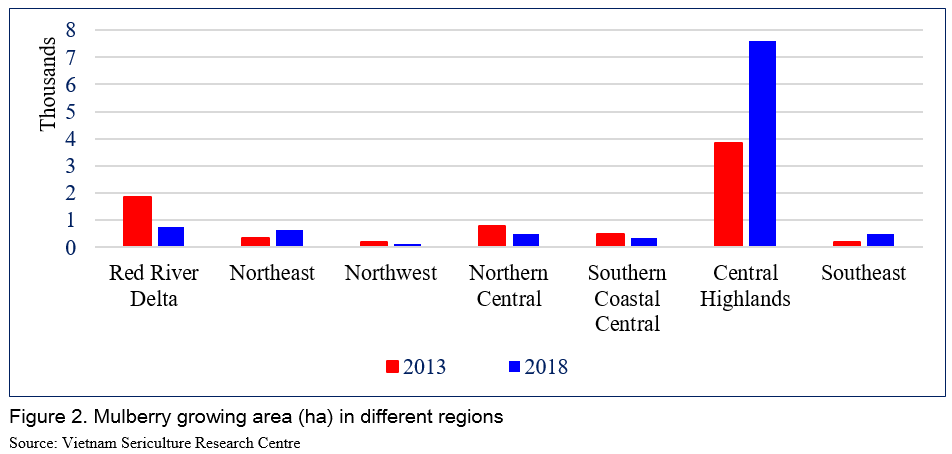
The change in mulberry growing area shows different trends. The growing area in three regions including Central Highlands, the Northeast and the Southeast increased, whereas the remaining regions have decreased. The reason is due to the restructuring of crops, urbanization, industrialization and labor movement from agriculture, sericulture to other industries with stable and higher income (Figure 2).
In the Central Highlands region, Lam Dong province has the largest scale of mulberry growing, silkworm raising, thread extracting, silk weaving and silk export. It can be affirmed that these activities in Lam Dong are core activities of the Vietnamese sericulture value chain (Table 2).

The criteria of mulberry growing area, cocoons yield, silk yield and silk export turnover of Lam Dong account for 77% to 99% compared to those criteria of the entire Vietnamese sericulture value chain.
Vietnamese sericulture value chain map
The Vietnamese sericulture value chain is organized and operated according to the following value chain mapping:
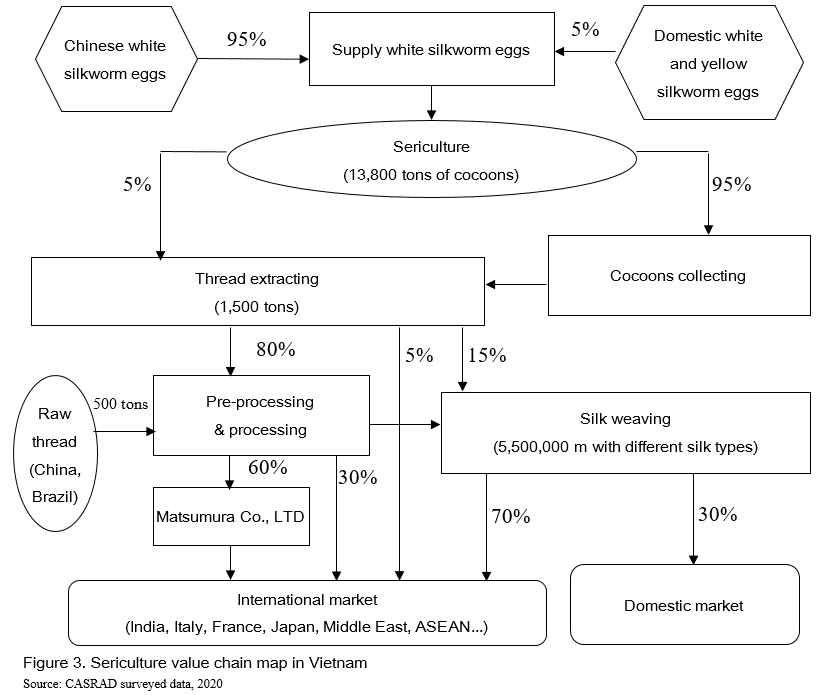
The Vietnamese sericulture value chain attracts the participation of many different groups of actors including supplying silkworm eggs, raising silkworms (immature and mature), collecting cocoons, extracting thread, processing thread, and weaving silk. The above groups of actors include households, business households and enterprises. The main thread consumption market is for export, accounting for over 80% and about 20% of the domestic consumption is for weaving all kinds of silk.
Characteristics of actors in the Vietnam sericulture value chain
The suppliers of silkworm eggs
There are three main varieties of silkworms that are being used currently, including bivoltine white cocoon silkworm variety, polyvoltine yellow cocoon silkworm variety and hybrid variety (between bivoltine white cocoon silkworm and polyvoltine yellow cocoon silkworm). In which, the bivoltine white cocoon silkworm variety with higher yield and silk quality should be used mainly, accounting for 100% of silkworm raising households in the Northern Mountainous region, Central Highlands and this figure is 40% in the Red River Delta.
The procedure of bivoltine white cocoon silkworm eggs producing is very complicated, so up to 95% of white cocoon silkworm eggs are imported from China by actors from Hung Yen, Nam Dinh and Lam Dong. The importation is completely by unofficial channels; therefore, there are many risks for domestic silkworm raising farmers because the source of imported silkworm eggs can be suddenly halted such as during the period of the COVID-19 pandemic.
The total amount of silkworm eggs imported from China in 2019 is about 500,000 boxes (20 grams/box). The scale of operation of the silkworm eggs supplying actors depends on the location and their own capital. For households that supply silkworm eggs, they import 4 to 6 times per month on average. Households with large operation scale import an average of over 1,000 egg boxes/time, small-scale households import an average of 100 boxes/time. After being imported, silkworm eggs are immediately provided to households that raise and trade immature silkworms. The selling price of bivoltine white cocoon silkworm eggs in the Northern provinces is US$3.5-3.9/eggs ring (about 6 grams/ring). In Lam Dong, the selling price is US$8.7-9.1/eggs box (20g/box, including 3 rings). The price of polyvoltine golden cocoon silkworm eggs is about US$1.7/eggs ring and only one-half of the price of bivoltine white cocoon silkworm eggs.
Mulberry growing and silkworm raising actors
Mulberry growing and silkworm raising actors are divided into two types including raising immature and mature silkworms.
Immature silkworm raising: they raise silkworms until the age of 2 or 3 (from 7-10 days after the eggs hatch). In Vietnam, there are 350-400 households that raise immature silkworms to provide for mature silkworm raising households. The biggest number of immature silkworm raising households is in Lam Dong (300 households) with a production scale from less than 500 egg cartons/month to over 1,000 egg boxes/month. In Yen Bai, there are 20-30 households raising immature silkworms. In which, in Tran Yen, there is a cooperative group and 18 households participating in this activity. Conditions for raising immature silkworms that need to be met are: (i) Having experience in raising silkworms; (ii) Having a large mulberry growing area; (iii) There are air-conditioned raising houses and farming equipment.
There is a strict connection and information exchange between immature and mature silkworm raising households. Before buying silkworm eggs, the immature silkworm raising households contact mature silkworm raising households to get information on quantity and timing that need to buy. In order to share difficulties with mature silkworm raising households due to the drop in the cocoons price that is affected by the COVID-19 pandemic, immature silkworm suppliers in Lam Dong actively reduced US$3.5-3.9/box of eggs.
The selling price of immature silkworms bases on the age of silkworms, the older the silkworm, the higher the selling price. The selling price of silkworms-age-2 in Lam Dong is US$21.7/box (20 grams of eggs), silkworms-age-3 are US$39.1/box.
Raising mature silkworms: This stage lasts from 12 to 13 days, from the silkworms -age-3 to when the silkworms enter the cocoons. Basically, the mature silkworm raising households ensure the mulberry growing area and have family members involved in production. The whole country has about 20,000 raising households, the average raising scale in Lam Dong is 2 boxes of egg (40 grams)/household/generation, raising about 10.5 generations/year. Each household have an area of mulberry growing of 4,000 – 5,000 m2/household with land use right. In the region, there is no available land for renting. In Yen Bai, on average, 2 egg rings (16 grams)/household/generation, 7.5 generations /year and mulberry growing area is from 500 to 600 m2/household.
Regarding the current mature silkworm raising technique, which is harvesting mulberry leaves and raising silkworms on the house floor. In Yen Bai, households mainly still use bamboo frames so the percentage of double, thin, rotten cocoons is still high. In Lam Dong, 100% of the households use wood frames; therefore, the cocoons are collected evenly, the percentage of abnormal cocoons is low.
After harvesting cocoons, 95% of households sell cocoons to collectors, the remaining 5% sell cocoons directly to thread extraction agencies. The price of the cocoons depends on the quality of the cocoon. The high-quality cocoons are the 3-day-sleeping cocoons, the cocoons' appearance is round, hard, and white; whereas poor quality cocoons are abnormal cocoons, double cocoons, and black cocoons.
The price of cocoons in Yen Bai is always lower than that in Lam Dong due to the lower cocoon quality (small cocoons produce short thread; high percentage of double and abnormal cocoon, etc.). The highest selling price of cocoons between 2018 and 2020 reached US$9.1/kg. However, the price of cocoons has decreased in 2020. The main reason is that thread extracting agencies have difficulties in exporting silk when silk importing countries implement trade restrictions to prevent the COVID-19 pandemic.
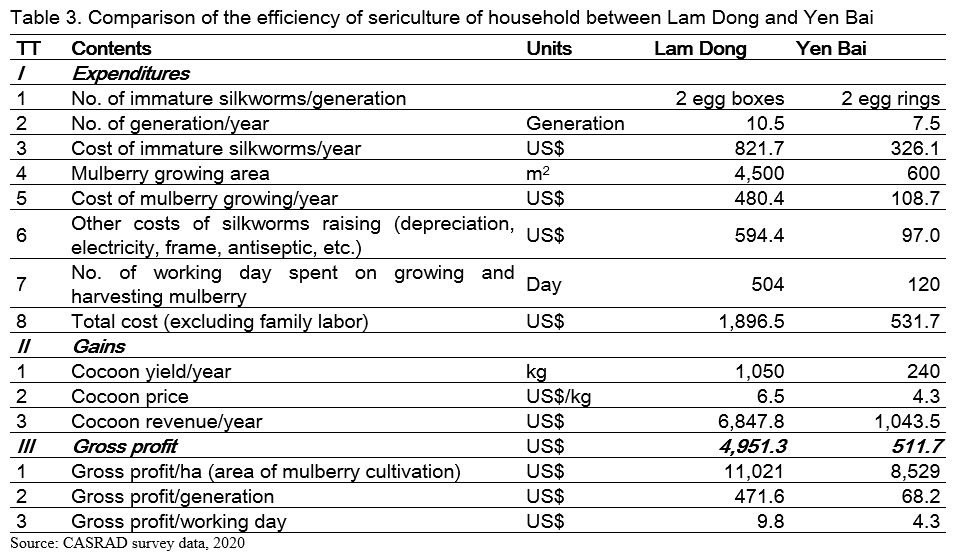
Comparing the scale and efficiency of sericulture shows that the production scale and investment costs of households in Lam Dong are much larger than those in Yen Bai. In 2019, the total investment cost for mulberry growing and silkworm raising (excluding family labor) of households in Lam Dong was US$1,896.5, 3.5 times higher than that in Yen Bai. With the average price of cocoons reaching US$6.5/kg, the total revenue of silkworm raising households in the surveyed households in Lam Dong reached US$6,847.8. Meanwhile in Yen Bai, because the average price of cocoons is US$4.4/kg, the revenue from sericulture is only US$1,043.5. The index of efficiency assessment is the gross profit/hectare area of mulberry growing which in Lam Dong reached US$11,000, it was higher than that in Yen Bai, US$2478.3. The average income (gross profit) of worker in Lam Dong is US$9.8/worker, more than 2 times higher than that in Yen Bai.
Cocoons collecting actors
Cocoon collecting actors in Lam Dong and Yen Bai are mainly households; however, the purchasing scale in Lam Dong is larger (from 500 to 1,000 kg/day). They use motorbikes to go to farmers’ houses to collect and transport to the gathering point. After collecting enough desired amount, most of collecting actors use trucks (Lam Dong) or coaches (Yen Bai) to transport cocoons to thread extracting agencies. These are non-specialized modes of cocoon transportation because these vehicles do not have cold storage containers. For mulberry growing areas that are close to thread extracting location, the transportation distance is short, so the risk of loss and damage to the cocoon is low. In contrast, for silkworm growing regions that are far from thread extracting location (Nam Dinh), this mode of transport has a great influence on the quality of the cocoons.
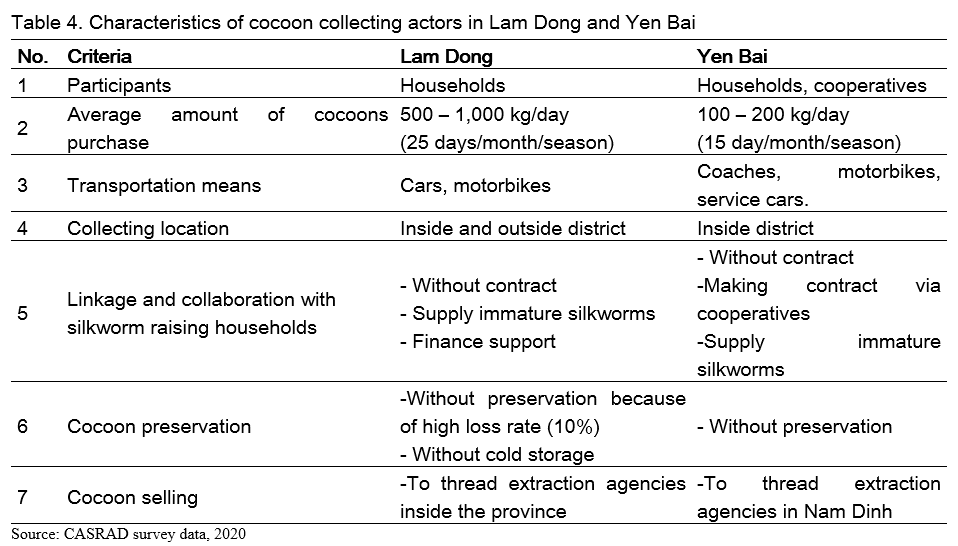
The linkage between large cocoon collectors and immature silkworm raising households is normally not strict, without purchasing contract. In order to buy cocoons, the collectors often provide immature silkworms and lend money to households. However, when the price of cocoons is high, the competition among collectors is very common.
Thread extracting actors
Comparing between thread extracting agencies in Lam Dong and the Red River Delta shows that there are big differences in production scale, technology, and investments:
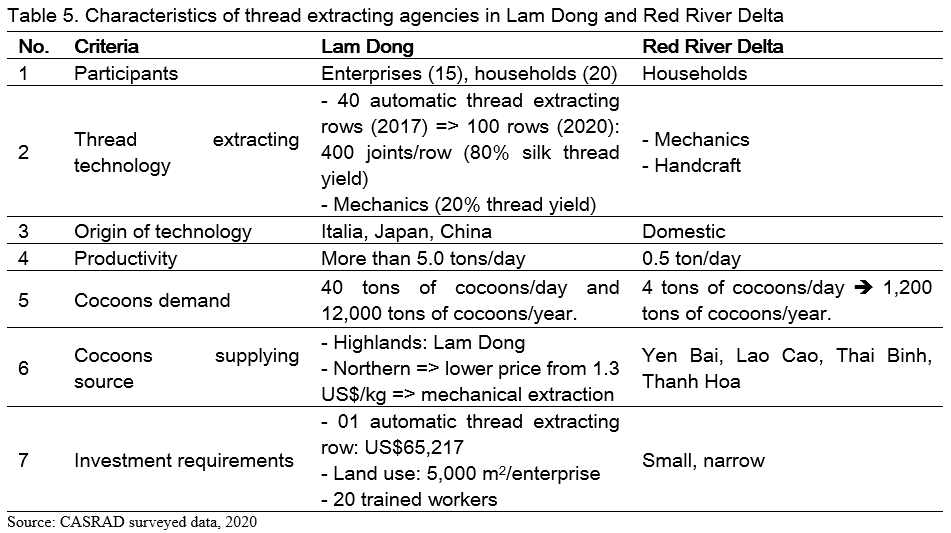
The surveyed results in Lam Dong have shown that to invest in an automatic thread extracting row, the investment capital for machinery is US$65,217and the minimum factory area is 5,000 m2 (Table 5). For efficient operation, an automatic thread extracting row requires 20 trained and technically proficient workers. These investment requirements do not exceed the capacity of enterprises in provinces with sericulture activities such as Lao Cai and Yen Bai. In order to improve the operational efficiency of the sericulture in the coming time, Yen Bai province can attract and support businesses to invest in automatic thread extracting system within the province. That will help to raise cocoons selling of farmers, create added value and jobs in the province's sericulture value chain.
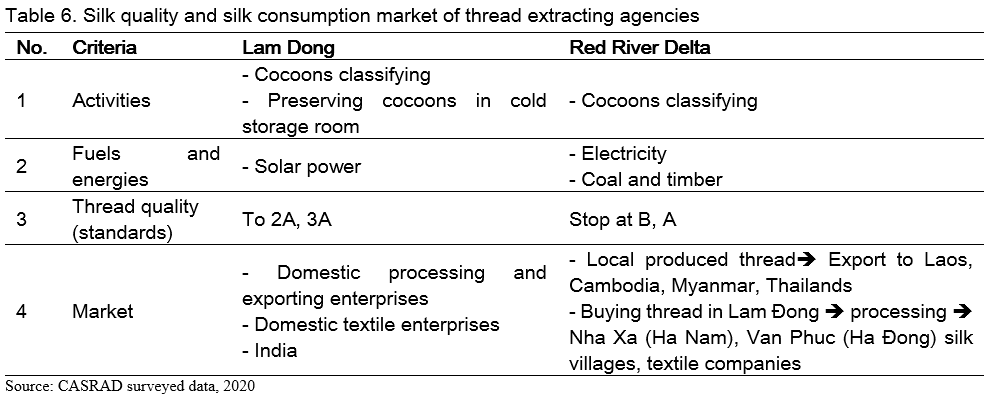
The international silk thread quality standard is divided into 10 grades with quality reducing gradually: 6A, 5A, 4A, 3A, 2A, A, B, C, D, E. Like many silk products such as: Satin silk thread to make kimono (Japan), Yozu to make head scarves, wraps (Middle East), Habuta, CDC ... for sewing tunics, high-end clothes, cravat, blankets, cushions... High-end silk requirements are 5A and 6A standards, while domestic silk thread is not up to Chinese standard due to lower thread extracting technology. So, silk weaving companies must import higher quality silk thread from China and Brazil.
The Chinese silk thread can attend highest grade such as 4A, 5A, and 6A, while Lam Dong silk thread in general attends only standard 2A and 3A. Silk thread in Lam Dong has higher quality which meets 2A and 3A standards, while silk thread from agencies in the Red River Delta only stops at B and A standards. Therefore, after extracting, Lam Dong silk thread is sold to domestic silk processing, textile and exporting enterprises or directly export to the Indian market. In contrast, in the Red River Delta, silk is mainly exported by unofficial channels to Laos, Cambodia, Myanmar, and Thailand to make traditional costumes (dresses, shirts, brocade scarves). In order to supply thread for silk villages such as Nha Xa and Van Phuc, a number of thread extracting agencies in the Red River Delta have imported silk from Lam Dong for preliminary processing, processing and resale to these villages.
In recent years, a number of thread extracting agencies in Lam Dong have invested in researching and extracting beneficial ingredients and active ingredients for health care or beauty from silkworm cocoons and pupae. This activity has created sample products such as cosmetics, skin creams, functional foods that have been analyzed, tested and evaluated for quality. This is an opportunity to help create added value and diversify product categories for the Vietnamese mulberry silk value chain.
Silk pre-processing actors
Silk pre-processing includes specific activities such as silk cleaning, silk washing, silk spinning, silk dyeing, silk sorting and packing. Depending on the requirements of the customers (textile factory, silk export company, importer), silk will be made according to different pre-processing stages.
In the Red River Delta, the silk spinning agencies are mainly located in Nam Dinh province. There are two main sources of silk, which are pre-processed silk in Lam Dong province and in the Northern provinces. Depending on the partner's request, the agency buys pre-processed silk in Lam Dong, then spins it into 3 - 4 strands or 5 - 6 strands. The types of silk produced in the North are only cleaned and then sold because of impurities contamination, the cost for silk cleaning is US$0.87/kg.
In Lam Dong, silk pre-processing is carried out by enterprises. The main pre-processing activities focus on boiling and dyeing silk using mechanical technology. On average, every year, factories in Vietnam Sericulture Corporation, JSC purchase, pre-process and supply to the market around 500 tons of silk and 100 tons of dyed silk. The quality of Lam Dong silk after pre-processing is qualified for direct export.
After being pre-processed, Lam Dong silk is shiner, softer and smoother. In contrast, Nam Dinh silk is rougher and harder due to quality of thread difference.
Silk weaving actors
In the Red River Delta: a survey at Nha Xa silk village shows that there are 2 main sources of raw silk: silk produced in Lam Dong and silk imported from China. Depending on the requirements of the ordering partner, the textile agencies decide the type of silk to use. For products that do not require patterned silk such as towels, duvet and pillows cover, etc., Lam Dong silk will be preferred because of its lower price. In the market the patterned silk products in general have higher price due to more complicated weaving technic. So, for this patterned silk, it is necessary to use more Chinese higher quality fiber to make patterns become more beautiful, more shining. The ratio of using thread is 1:1, which means 1 vertical thread of Lam Dong silk is woven with 1 horizontal thread of Chinese silk. The higher quality of Chinese silk thread due the higher Chinese technology comparing to Vietnamese technology. Silk weaving technology in Nha Xa village is all outdated technology used by textile factories, companies in Vietnam and China. Finished silk is sold directly to agencies, silk shops in domestic tourist destinations such as: silk shops in the old quarters of Hanoi, Da Nang, Hoi An, Ho Chi Minh that serve the tourist market. Otherwise, silk can be sold to handicraft export centers, high-end fashion domestic manufacturing companies.
In Lam Dong, there are 10 silk weaving enterprises using modern technology machines. Total silk yield in Vietnam is about 5,500,000 m/year, equal to using 370 tons of silk/year. Thus, domestic silk weaving activities consume 25% of the total.
To promote and introduce Vietnamese silk products, thread extracting and silk weaving enterprises in Lam Dong participated in international silk exhibitions held in India, Switzerland, France, etc. In the domestic market, Lam Dong province and businesses directly or collaboratively organize many activities such as Silk Week (the main content of Da Lat Flower Festival); Silk Fashion Week; Building points to introduce and sell products in urban and tourist centers (Ho Chi Minh City, Da Lat, Nha Trang, Hue, Hoi An, Hanoi, Quang Ninh) such as VietNam silk house stores; Establishing Vietnamese silk website.
However, it can be seen that silk products consumed in the Vietnamese market do not come with a system of identification, labeling and traceability. The People's Committee of Bao Loc city (Lam Dong) has registered the trademark protection for Bao Loc silk products. After being protected, Bao Loc City People's Committee granted the right to use the trademark to 14 businesses in the region. In fact, businesses have not yet exploited the trademark for advertising, trade promotion and product consumption. This is a limitation for consumers to properly recognize, understand and trust the product. Therefore, Vietnamese silk products continue to suffer from unfair competition from unknown origin products. Consumers do not consume products with a true quality and value.
Accounting for economic efficiency of actors in the sericulture value chain
Calculating the efficiency of different actors participating in the sericulture value chain in Lam Dong shows that, with the same input unit of immature silkworm, the mature silkworm raising actors earn the highest gross profit.
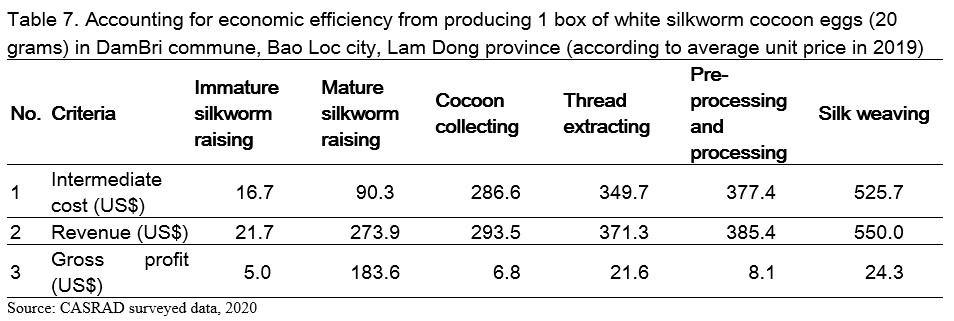
In DamBri commune, when raising 1 box of silkworm eggs (20 grams), immature silkworm raising farmers will only get a gross profit of US$5 while mature silkworm raising farmers will get a gross profit of US$183.6 followed by thread extracting and silk weaving actors. This part of the accounting does not include family labor. Among the above groups of actors, the mature silkworm raising households use the most family labor, so although the gross profit margin is high, in terms of the index of gross profit/labor, it only reaches US$10-11/working day. This level of wages is still lower than that of workers in industrial factories and service workers. This is the reason why the proportion of young workers participating in the sericulture value chain is decreasing, most of the workers participating in this value chain are middle-aged and elderly workers.
Difficulties and limitations in the Vietnamese sericulture value chain
From the analysis results of the sericulture value chain, there are still some difficulties and limitations as follows (Table 8):
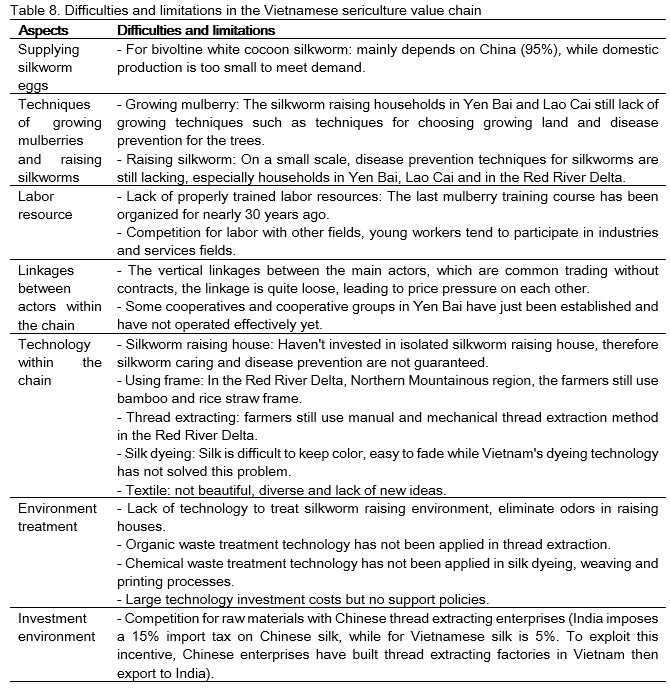
From the above limitations and difficulties, solutions are proposed to develop the Vietnamese sericulture value chain in the near future.
Solutions to develop the Vietnamese sericulture value chain
Building linkages between production and consumption organizations and technology transfer within the train:
Consolidating and establishing new cooperatives and cooperative groups among sericulture households in order to provide technical support and connect consumption markets;
Linking between sericulture research institutions and cooperatives to transfer technology of growing mulberry and raising silkworms;
Linking between silk weaving agencies to textile training institutions to research and transfer technology of silk weaving, dyeing, printing and designing;
Enhancing and promoting the role and responsibility of the Vietnam Sericulture Association, paying special attention to the official import of silkworm eggs and providing information on the products’ consumption market.
Building a Vietnamese silk brand through product promotion and introduction
Assigning the Vietnam Sericulture Association to manage and develop the Vietnamese silk brand;
Organizing promotional activities, introducing Vietnamese silk at domestic and international fashion, cultural and tourism events;
Setting up tours to visit silk villages, thread extracting and silk weaving centers that introduce and sell products.
Diversifying designs and products from silk to serve the domestic market
Encouraging agencies, organizations and businesses to use the office uniform such as suits, Ao Dai, skirts, shirts made by silk;
Researching and completing beauty products and functional foods.
Supporting the construction and development of silk products that meet the national 5-stars OCOP standard.
To solve the above difficulties, it is necessary to build linkages between production and consumption and transfer technology; Build a Vietnamese silk brand, promote and introduce products associated with tourism; Diversify designs and products from silk to serve the domestic market.
CONCLUSION
The research results of Vietnam's sericulture value chain show that:
The Vietnamese sericulture value chain attracts the participation of many different groups of actors such as supplying silkworm eggs, raising silkworms (immature and mature), collecting cocoons, extracting thread, pre-processing and processing silk, and weaving silk. The organization type of the above groups of actors includes households, business households and enterprises.
Ongoing trends for the Vietnamese sericulture value chain are: (1) Reducing yellow cocoon silkworms in current silkworm raising regions, expanding white cocoon silkworm raising in the Northeast and Central Highlands; (2) Expanding the mulberry growing area in the Red River Delta, North Central and South Central regions, whereas expanding production area in the Northeast and Central Highlands provinces; (3) Exporting golden cocoons, mechanical and handmade silk in the Red River Delta to Laos, Cambodia, and Myanmar to manufacture traditional costumes (skirts, brocade shirts); (4) Exporting silk and white cocoons to India, Europe, and Japan to manufacture high-value fashion products, a small part is produced to serve the domestic market.
Accounting for economic efficiency per unit of bivoltine white cocoon eggs (1 box = 20g eggs) shows that mature silkworm raising households get the largest gross profit margin. However, if we calculate the value of the labor-day, the income is still lower than that of workers in industrial factories and service workers, leading to the proportion of young workers participating in the sericulture value chain decreases by the time.
The Vietnamese sericulture value chain is facing difficulties in: (1) The supply of silkworm eggs; (2) Farmers in newly established regions lack the technology of growing mulberries and raising silkworms; (3)The competition in terms of labor between sericulture and other fields such as industry and service; (4) The linkage between actors within the value chain is not strict; (5) The technology of silkworm raising, thread extracting, and silk weaving in regions outside Lam Dong is still limited; (6) Environmental treatment technology has not been applied in processing; and (7) Competition for raw materials with Chinese thread extractors.
To solve the above difficulties, it is necessary to build linkages between production and consumption and transfer technology; Build a Vietnamese silk brand, promote and introduce products associated with tourism; Diversify designs and products from silk to serve the domestic market.
REFERENCES
Report on Vietnam sericulture – Vietnam Sericulture Research Centre, 2016.
GTZ Eschborn, 2007. The ValueLinks Handbook: Methodology for Value Chain Promotion.
Nguyen Van Bo and Dao The Anh, 2013. Solutions to enhance added value in the value chain of agricultural products in Vietnam.
Website: www.inserco.org , accessed 10/22/2020.


Development of Sericulture Value Chain in Vietnam
ABSTRACT
Sericulture is a Vietnamese traditional job and is also a source of livelihood for many farmers. This is why it is important to do research work on Vietnamese sericulture value chain in order to come up with solutions for development in the future. The research methods include approaching value chain; and approaching with participatory, secondary and primary information collection methods. The research has shown that Lam Dong province fits the criteria and requirements of mulberry growing area, cocoons yield, silk yield and silk, thread export turnover accounting for 77% to 99% of the whole country. There are three main types of silkworms that are being used by farmers, in which the bivoltine white cocoon silkworm has higher silk yield and quality, so it occupies for 100% of silkworm farming households in the Northern Mountainous region (MNPB) and the Central Highlands and 40% of households in Red River Delta. The value chain diagram shows that there are many actors participating in the chain such as silkworm eggs suppliers, sericulture households, cocoons collectors and silk weavers. Analyzing the characteristics of the actors within the value chain shows that silkworm egg source depends mainly on China (imported 95%); The link among actors is still loose; Production techniques and technology are still outdated in the Red River Delta and the Northern Mountainous region. Sericulture households have low income per working day, so they cannot attract the participation of young workers. From the existing difficulties, solutions have been proposed including creating linkages between production and consumption and transfer of technology; building a Vietnamese silk brand, promoting and introducing products associated with tourism; diversifying designs and products to supply the domestic market.
Keywords: value chain, sericulture, Vietnam
INTRODUCTION
Sericulture is a traditional job of Vietnam with characteristics of a combination of cultivation, animal husbandry, processing technology and art. Despite the fierce competition of many types of synthetic silk produced in large volumes at a low cost, it still cannot replace the position of traditional silk because of its unique characteristics such as continuous length, softness and its being environmentally friendly. Sericulture is still a source of livelihood for many farmers across the country. In recent times, along with the increase in consumer demand for high-quality silk products from major markets around the world such as Japan, India, Italy, France, etc. it has promoted the development of Vietnamese sericulture. The total export value has reached US$60 million making Vietnam belong to the group of 5 largest silk producing countries in the world (www.inserco.org, accessed October 22, 2020). However, due to the limitations of farmers, especially the small mulberry growing area, the Vietnamese sericulture is having a strategic shift from the traditional region of Red River Delta to mountainous regions such as Lam Dong in the South and Yen Bai in the North, etc. (Report - Vietnam Sericulture Research Centre). It is important to study the Vietnamese sericulture value chain in order to assess the current operational status, thereby identifying difficulties and obstacles and proposing solutions to develop the Vietnamese sericulture value chain in the near future.
METHODS
Methods: using the approaching value chain and participatory methods to fully assess the organization, participation and role of actors in the agriculture value chain.
Information collecting methods:
Collecting and processing information methods: The collected information is classified and sorted according to different criteria. The surveyed data is organized and processed on the computer using Microsoft Excel (Table 1).
RESULTS AND DISCUSSIONS
Overview of Vietnam sericulture production
From 2010 to 2014, mulberry growing area and cocoons yield decreased. The growing area reduced from 8,550 ha (2010) to 7,663 ha (2014), the cocoons yield decreased from 7,107 tons (2010) to 6,543 tons (2015). Between 2016 and 2018, the mulberry growing area and cocoons yield increased, reaching 10,454 ha and 8,294 tons respectively. One of the main reasons for this change is the increase of cocoons price. In 2017, the highest cocoons selling price reached US$7.4/kg and was 1.5 times higher than in the previous period (Figure 1).
The change in mulberry growing area shows different trends. The growing area in three regions including Central Highlands, the Northeast and the Southeast increased, whereas the remaining regions have decreased. The reason is due to the restructuring of crops, urbanization, industrialization and labor movement from agriculture, sericulture to other industries with stable and higher income (Figure 2).
In the Central Highlands region, Lam Dong province has the largest scale of mulberry growing, silkworm raising, thread extracting, silk weaving and silk export. It can be affirmed that these activities in Lam Dong are core activities of the Vietnamese sericulture value chain (Table 2).
The criteria of mulberry growing area, cocoons yield, silk yield and silk export turnover of Lam Dong account for 77% to 99% compared to those criteria of the entire Vietnamese sericulture value chain.
Vietnamese sericulture value chain map
The Vietnamese sericulture value chain is organized and operated according to the following value chain mapping:
The Vietnamese sericulture value chain attracts the participation of many different groups of actors including supplying silkworm eggs, raising silkworms (immature and mature), collecting cocoons, extracting thread, processing thread, and weaving silk. The above groups of actors include households, business households and enterprises. The main thread consumption market is for export, accounting for over 80% and about 20% of the domestic consumption is for weaving all kinds of silk.
Characteristics of actors in the Vietnam sericulture value chain
The suppliers of silkworm eggs
There are three main varieties of silkworms that are being used currently, including bivoltine white cocoon silkworm variety, polyvoltine yellow cocoon silkworm variety and hybrid variety (between bivoltine white cocoon silkworm and polyvoltine yellow cocoon silkworm). In which, the bivoltine white cocoon silkworm variety with higher yield and silk quality should be used mainly, accounting for 100% of silkworm raising households in the Northern Mountainous region, Central Highlands and this figure is 40% in the Red River Delta.
The procedure of bivoltine white cocoon silkworm eggs producing is very complicated, so up to 95% of white cocoon silkworm eggs are imported from China by actors from Hung Yen, Nam Dinh and Lam Dong. The importation is completely by unofficial channels; therefore, there are many risks for domestic silkworm raising farmers because the source of imported silkworm eggs can be suddenly halted such as during the period of the COVID-19 pandemic.
The total amount of silkworm eggs imported from China in 2019 is about 500,000 boxes (20 grams/box). The scale of operation of the silkworm eggs supplying actors depends on the location and their own capital. For households that supply silkworm eggs, they import 4 to 6 times per month on average. Households with large operation scale import an average of over 1,000 egg boxes/time, small-scale households import an average of 100 boxes/time. After being imported, silkworm eggs are immediately provided to households that raise and trade immature silkworms. The selling price of bivoltine white cocoon silkworm eggs in the Northern provinces is US$3.5-3.9/eggs ring (about 6 grams/ring). In Lam Dong, the selling price is US$8.7-9.1/eggs box (20g/box, including 3 rings). The price of polyvoltine golden cocoon silkworm eggs is about US$1.7/eggs ring and only one-half of the price of bivoltine white cocoon silkworm eggs.
Mulberry growing and silkworm raising actors
Mulberry growing and silkworm raising actors are divided into two types including raising immature and mature silkworms.
Immature silkworm raising: they raise silkworms until the age of 2 or 3 (from 7-10 days after the eggs hatch). In Vietnam, there are 350-400 households that raise immature silkworms to provide for mature silkworm raising households. The biggest number of immature silkworm raising households is in Lam Dong (300 households) with a production scale from less than 500 egg cartons/month to over 1,000 egg boxes/month. In Yen Bai, there are 20-30 households raising immature silkworms. In which, in Tran Yen, there is a cooperative group and 18 households participating in this activity. Conditions for raising immature silkworms that need to be met are: (i) Having experience in raising silkworms; (ii) Having a large mulberry growing area; (iii) There are air-conditioned raising houses and farming equipment.
There is a strict connection and information exchange between immature and mature silkworm raising households. Before buying silkworm eggs, the immature silkworm raising households contact mature silkworm raising households to get information on quantity and timing that need to buy. In order to share difficulties with mature silkworm raising households due to the drop in the cocoons price that is affected by the COVID-19 pandemic, immature silkworm suppliers in Lam Dong actively reduced US$3.5-3.9/box of eggs.
The selling price of immature silkworms bases on the age of silkworms, the older the silkworm, the higher the selling price. The selling price of silkworms-age-2 in Lam Dong is US$21.7/box (20 grams of eggs), silkworms-age-3 are US$39.1/box.
Raising mature silkworms: This stage lasts from 12 to 13 days, from the silkworms -age-3 to when the silkworms enter the cocoons. Basically, the mature silkworm raising households ensure the mulberry growing area and have family members involved in production. The whole country has about 20,000 raising households, the average raising scale in Lam Dong is 2 boxes of egg (40 grams)/household/generation, raising about 10.5 generations/year. Each household have an area of mulberry growing of 4,000 – 5,000 m2/household with land use right. In the region, there is no available land for renting. In Yen Bai, on average, 2 egg rings (16 grams)/household/generation, 7.5 generations /year and mulberry growing area is from 500 to 600 m2/household.
Regarding the current mature silkworm raising technique, which is harvesting mulberry leaves and raising silkworms on the house floor. In Yen Bai, households mainly still use bamboo frames so the percentage of double, thin, rotten cocoons is still high. In Lam Dong, 100% of the households use wood frames; therefore, the cocoons are collected evenly, the percentage of abnormal cocoons is low.
After harvesting cocoons, 95% of households sell cocoons to collectors, the remaining 5% sell cocoons directly to thread extraction agencies. The price of the cocoons depends on the quality of the cocoon. The high-quality cocoons are the 3-day-sleeping cocoons, the cocoons' appearance is round, hard, and white; whereas poor quality cocoons are abnormal cocoons, double cocoons, and black cocoons.
The price of cocoons in Yen Bai is always lower than that in Lam Dong due to the lower cocoon quality (small cocoons produce short thread; high percentage of double and abnormal cocoon, etc.). The highest selling price of cocoons between 2018 and 2020 reached US$9.1/kg. However, the price of cocoons has decreased in 2020. The main reason is that thread extracting agencies have difficulties in exporting silk when silk importing countries implement trade restrictions to prevent the COVID-19 pandemic.
Comparing the scale and efficiency of sericulture shows that the production scale and investment costs of households in Lam Dong are much larger than those in Yen Bai. In 2019, the total investment cost for mulberry growing and silkworm raising (excluding family labor) of households in Lam Dong was US$1,896.5, 3.5 times higher than that in Yen Bai. With the average price of cocoons reaching US$6.5/kg, the total revenue of silkworm raising households in the surveyed households in Lam Dong reached US$6,847.8. Meanwhile in Yen Bai, because the average price of cocoons is US$4.4/kg, the revenue from sericulture is only US$1,043.5. The index of efficiency assessment is the gross profit/hectare area of mulberry growing which in Lam Dong reached US$11,000, it was higher than that in Yen Bai, US$2478.3. The average income (gross profit) of worker in Lam Dong is US$9.8/worker, more than 2 times higher than that in Yen Bai.
Cocoons collecting actors
Cocoon collecting actors in Lam Dong and Yen Bai are mainly households; however, the purchasing scale in Lam Dong is larger (from 500 to 1,000 kg/day). They use motorbikes to go to farmers’ houses to collect and transport to the gathering point. After collecting enough desired amount, most of collecting actors use trucks (Lam Dong) or coaches (Yen Bai) to transport cocoons to thread extracting agencies. These are non-specialized modes of cocoon transportation because these vehicles do not have cold storage containers. For mulberry growing areas that are close to thread extracting location, the transportation distance is short, so the risk of loss and damage to the cocoon is low. In contrast, for silkworm growing regions that are far from thread extracting location (Nam Dinh), this mode of transport has a great influence on the quality of the cocoons.
The linkage between large cocoon collectors and immature silkworm raising households is normally not strict, without purchasing contract. In order to buy cocoons, the collectors often provide immature silkworms and lend money to households. However, when the price of cocoons is high, the competition among collectors is very common.
Thread extracting actors
Comparing between thread extracting agencies in Lam Dong and the Red River Delta shows that there are big differences in production scale, technology, and investments:
The surveyed results in Lam Dong have shown that to invest in an automatic thread extracting row, the investment capital for machinery is US$65,217and the minimum factory area is 5,000 m2 (Table 5). For efficient operation, an automatic thread extracting row requires 20 trained and technically proficient workers. These investment requirements do not exceed the capacity of enterprises in provinces with sericulture activities such as Lao Cai and Yen Bai. In order to improve the operational efficiency of the sericulture in the coming time, Yen Bai province can attract and support businesses to invest in automatic thread extracting system within the province. That will help to raise cocoons selling of farmers, create added value and jobs in the province's sericulture value chain.
The international silk thread quality standard is divided into 10 grades with quality reducing gradually: 6A, 5A, 4A, 3A, 2A, A, B, C, D, E. Like many silk products such as: Satin silk thread to make kimono (Japan), Yozu to make head scarves, wraps (Middle East), Habuta, CDC ... for sewing tunics, high-end clothes, cravat, blankets, cushions... High-end silk requirements are 5A and 6A standards, while domestic silk thread is not up to Chinese standard due to lower thread extracting technology. So, silk weaving companies must import higher quality silk thread from China and Brazil.
The Chinese silk thread can attend highest grade such as 4A, 5A, and 6A, while Lam Dong silk thread in general attends only standard 2A and 3A. Silk thread in Lam Dong has higher quality which meets 2A and 3A standards, while silk thread from agencies in the Red River Delta only stops at B and A standards. Therefore, after extracting, Lam Dong silk thread is sold to domestic silk processing, textile and exporting enterprises or directly export to the Indian market. In contrast, in the Red River Delta, silk is mainly exported by unofficial channels to Laos, Cambodia, Myanmar, and Thailand to make traditional costumes (dresses, shirts, brocade scarves). In order to supply thread for silk villages such as Nha Xa and Van Phuc, a number of thread extracting agencies in the Red River Delta have imported silk from Lam Dong for preliminary processing, processing and resale to these villages.
In recent years, a number of thread extracting agencies in Lam Dong have invested in researching and extracting beneficial ingredients and active ingredients for health care or beauty from silkworm cocoons and pupae. This activity has created sample products such as cosmetics, skin creams, functional foods that have been analyzed, tested and evaluated for quality. This is an opportunity to help create added value and diversify product categories for the Vietnamese mulberry silk value chain.
Silk pre-processing actors
Silk pre-processing includes specific activities such as silk cleaning, silk washing, silk spinning, silk dyeing, silk sorting and packing. Depending on the requirements of the customers (textile factory, silk export company, importer), silk will be made according to different pre-processing stages.
In the Red River Delta, the silk spinning agencies are mainly located in Nam Dinh province. There are two main sources of silk, which are pre-processed silk in Lam Dong province and in the Northern provinces. Depending on the partner's request, the agency buys pre-processed silk in Lam Dong, then spins it into 3 - 4 strands or 5 - 6 strands. The types of silk produced in the North are only cleaned and then sold because of impurities contamination, the cost for silk cleaning is US$0.87/kg.
In Lam Dong, silk pre-processing is carried out by enterprises. The main pre-processing activities focus on boiling and dyeing silk using mechanical technology. On average, every year, factories in Vietnam Sericulture Corporation, JSC purchase, pre-process and supply to the market around 500 tons of silk and 100 tons of dyed silk. The quality of Lam Dong silk after pre-processing is qualified for direct export.
After being pre-processed, Lam Dong silk is shiner, softer and smoother. In contrast, Nam Dinh silk is rougher and harder due to quality of thread difference.
Silk weaving actors
In the Red River Delta: a survey at Nha Xa silk village shows that there are 2 main sources of raw silk: silk produced in Lam Dong and silk imported from China. Depending on the requirements of the ordering partner, the textile agencies decide the type of silk to use. For products that do not require patterned silk such as towels, duvet and pillows cover, etc., Lam Dong silk will be preferred because of its lower price. In the market the patterned silk products in general have higher price due to more complicated weaving technic. So, for this patterned silk, it is necessary to use more Chinese higher quality fiber to make patterns become more beautiful, more shining. The ratio of using thread is 1:1, which means 1 vertical thread of Lam Dong silk is woven with 1 horizontal thread of Chinese silk. The higher quality of Chinese silk thread due the higher Chinese technology comparing to Vietnamese technology. Silk weaving technology in Nha Xa village is all outdated technology used by textile factories, companies in Vietnam and China. Finished silk is sold directly to agencies, silk shops in domestic tourist destinations such as: silk shops in the old quarters of Hanoi, Da Nang, Hoi An, Ho Chi Minh that serve the tourist market. Otherwise, silk can be sold to handicraft export centers, high-end fashion domestic manufacturing companies.
In Lam Dong, there are 10 silk weaving enterprises using modern technology machines. Total silk yield in Vietnam is about 5,500,000 m/year, equal to using 370 tons of silk/year. Thus, domestic silk weaving activities consume 25% of the total.
To promote and introduce Vietnamese silk products, thread extracting and silk weaving enterprises in Lam Dong participated in international silk exhibitions held in India, Switzerland, France, etc. In the domestic market, Lam Dong province and businesses directly or collaboratively organize many activities such as Silk Week (the main content of Da Lat Flower Festival); Silk Fashion Week; Building points to introduce and sell products in urban and tourist centers (Ho Chi Minh City, Da Lat, Nha Trang, Hue, Hoi An, Hanoi, Quang Ninh) such as VietNam silk house stores; Establishing Vietnamese silk website.
However, it can be seen that silk products consumed in the Vietnamese market do not come with a system of identification, labeling and traceability. The People's Committee of Bao Loc city (Lam Dong) has registered the trademark protection for Bao Loc silk products. After being protected, Bao Loc City People's Committee granted the right to use the trademark to 14 businesses in the region. In fact, businesses have not yet exploited the trademark for advertising, trade promotion and product consumption. This is a limitation for consumers to properly recognize, understand and trust the product. Therefore, Vietnamese silk products continue to suffer from unfair competition from unknown origin products. Consumers do not consume products with a true quality and value.
Accounting for economic efficiency of actors in the sericulture value chain
Calculating the efficiency of different actors participating in the sericulture value chain in Lam Dong shows that, with the same input unit of immature silkworm, the mature silkworm raising actors earn the highest gross profit.
In DamBri commune, when raising 1 box of silkworm eggs (20 grams), immature silkworm raising farmers will only get a gross profit of US$5 while mature silkworm raising farmers will get a gross profit of US$183.6 followed by thread extracting and silk weaving actors. This part of the accounting does not include family labor. Among the above groups of actors, the mature silkworm raising households use the most family labor, so although the gross profit margin is high, in terms of the index of gross profit/labor, it only reaches US$10-11/working day. This level of wages is still lower than that of workers in industrial factories and service workers. This is the reason why the proportion of young workers participating in the sericulture value chain is decreasing, most of the workers participating in this value chain are middle-aged and elderly workers.
Difficulties and limitations in the Vietnamese sericulture value chain
From the analysis results of the sericulture value chain, there are still some difficulties and limitations as follows (Table 8):
From the above limitations and difficulties, solutions are proposed to develop the Vietnamese sericulture value chain in the near future.
Solutions to develop the Vietnamese sericulture value chain
Building linkages between production and consumption organizations and technology transfer within the train:
Consolidating and establishing new cooperatives and cooperative groups among sericulture households in order to provide technical support and connect consumption markets;
Linking between sericulture research institutions and cooperatives to transfer technology of growing mulberry and raising silkworms;
Linking between silk weaving agencies to textile training institutions to research and transfer technology of silk weaving, dyeing, printing and designing;
Enhancing and promoting the role and responsibility of the Vietnam Sericulture Association, paying special attention to the official import of silkworm eggs and providing information on the products’ consumption market.
Building a Vietnamese silk brand through product promotion and introduction
Assigning the Vietnam Sericulture Association to manage and develop the Vietnamese silk brand;
Organizing promotional activities, introducing Vietnamese silk at domestic and international fashion, cultural and tourism events;
Setting up tours to visit silk villages, thread extracting and silk weaving centers that introduce and sell products.
Diversifying designs and products from silk to serve the domestic market
Encouraging agencies, organizations and businesses to use the office uniform such as suits, Ao Dai, skirts, shirts made by silk;
Researching and completing beauty products and functional foods.
Supporting the construction and development of silk products that meet the national 5-stars OCOP standard.
To solve the above difficulties, it is necessary to build linkages between production and consumption and transfer technology; Build a Vietnamese silk brand, promote and introduce products associated with tourism; Diversify designs and products from silk to serve the domestic market.
CONCLUSION
The research results of Vietnam's sericulture value chain show that:
The Vietnamese sericulture value chain attracts the participation of many different groups of actors such as supplying silkworm eggs, raising silkworms (immature and mature), collecting cocoons, extracting thread, pre-processing and processing silk, and weaving silk. The organization type of the above groups of actors includes households, business households and enterprises.
Ongoing trends for the Vietnamese sericulture value chain are: (1) Reducing yellow cocoon silkworms in current silkworm raising regions, expanding white cocoon silkworm raising in the Northeast and Central Highlands; (2) Expanding the mulberry growing area in the Red River Delta, North Central and South Central regions, whereas expanding production area in the Northeast and Central Highlands provinces; (3) Exporting golden cocoons, mechanical and handmade silk in the Red River Delta to Laos, Cambodia, and Myanmar to manufacture traditional costumes (skirts, brocade shirts); (4) Exporting silk and white cocoons to India, Europe, and Japan to manufacture high-value fashion products, a small part is produced to serve the domestic market.
Accounting for economic efficiency per unit of bivoltine white cocoon eggs (1 box = 20g eggs) shows that mature silkworm raising households get the largest gross profit margin. However, if we calculate the value of the labor-day, the income is still lower than that of workers in industrial factories and service workers, leading to the proportion of young workers participating in the sericulture value chain decreases by the time.
The Vietnamese sericulture value chain is facing difficulties in: (1) The supply of silkworm eggs; (2) Farmers in newly established regions lack the technology of growing mulberries and raising silkworms; (3)The competition in terms of labor between sericulture and other fields such as industry and service; (4) The linkage between actors within the value chain is not strict; (5) The technology of silkworm raising, thread extracting, and silk weaving in regions outside Lam Dong is still limited; (6) Environmental treatment technology has not been applied in processing; and (7) Competition for raw materials with Chinese thread extractors.
To solve the above difficulties, it is necessary to build linkages between production and consumption and transfer technology; Build a Vietnamese silk brand, promote and introduce products associated with tourism; Diversify designs and products from silk to serve the domestic market.
REFERENCES
Report on Vietnam sericulture – Vietnam Sericulture Research Centre, 2016.
GTZ Eschborn, 2007. The ValueLinks Handbook: Methodology for Value Chain Promotion.
Nguyen Van Bo and Dao The Anh, 2013. Solutions to enhance added value in the value chain of agricultural products in Vietnam.
Website: www.inserco.org , accessed 10/22/2020.